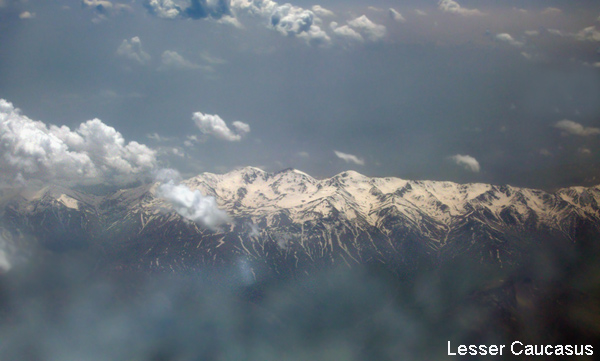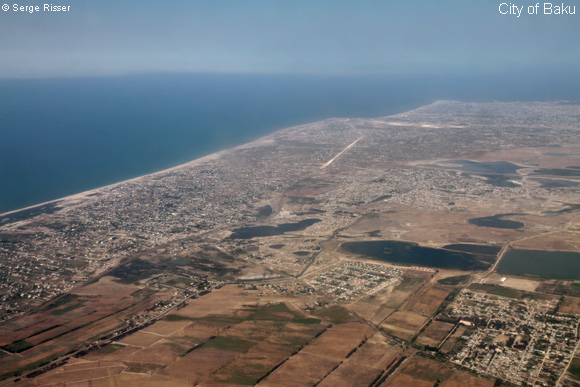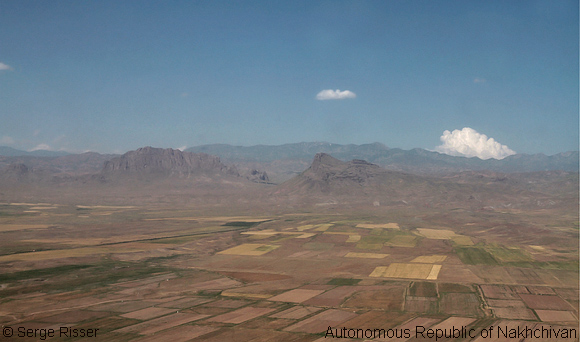AZERBAIJAN: Nakhchivan and Greater Caucasus
June 1st - 14th 2010
Benoît Paepegaey

At the south-eastern corner of Western Palaearctic, on the shore of the Caspian Sea and the slopes of the Caucasus lies a country still widely unknown to west European birdwatchers. Known to most of us for its oil fields, Azerbaijan has not so far managed to make it to the favourite destinations list of even the most adventurous west Palaearctic birders, as opposed to Eastern Turkey, Georgia and Armenia. Those were also the destinations I had selected for future trips to the south-east, when Serge contacted me last winter: he was planning to go to Azerbaijan with Pavel Simeonov (Branta Tours), who had already led a tour there the year before, and wanted to complete his knowledge of the field, in order to be able to offer the complete set of Caucasian specialities for his future tours. It really didn´t take much time to be convinced to join in the expedition!
Actually, we were not only going to Azerbaijan, and this is where it started to be really interesting: Pavel wanted to visit a place called Nakhchivan: a piece of Azerbaijan south-east of the Lesser Caucasus with no border with the main territory, surrounded by Iran, Armenia and Turkey. I had been looking for years at the Western Palaearctic map, and had never heard about it! This was truly going to be exciting, especially since many species that are absent or very hard to find in the main part of Azerbaijan could be expected there! After a few days in Nakhchivan, the plan was to move back to Baku and to travel north to the Greater Caucasus to see the emblematic species there and among them, a species I had been dreaming of for years: the Güldenstädt´s Redstart!
The plan was quite simple on the paper, but wasn't that easy on the administrative side and we only got confirmation a few days before departure that we would be allowed to enter Nakhchivan. It was a relief when the news came, although there was certainly enough to see in Azerbaijan even without this little extra!
Participants:
Serge Risser - France
Benoît Paepegaey - France
Pavel Simeonov - Tour leader (Branta-Tours)
Species recorded: 162

Description
June 1st, 2010:
Serge and I met up at Paris Charles de Gaulle airport and took our direct flight Paris-Baku on Azerbaijan airlines. The excitation rose after a few hours, when we reached the eastern shore of the Black Sea: a quick look to our right allowed us to sea the Batumi pass in Georgia, the rising hotspot for migrating raptors. And then we saw them: Lesser on the right, Greater on the left: both Caucasus were here, so close!

We landed on time in Baku and with no time proceeded to the passport control. After about an hour, we finally managed to get our visas and were free to discover Azerbaijan. Our local guide, was waiting for us at the airport. Pavel Simeonov was only arriving the day after, so we had a few hours to visit the Baku area. We settled at a cosy datcha and went for a few hours in the streets of Baku. Although most of the city and its suburbs are very busy and noisy compared with our standards, we were charmed by the old town and its historic monuments. The walk along the Caspian Sea (which, in fact, is a lake) was also quite enjoyable especially in these already hot conditions. Birds are far and few in the city, but Common Swifts were everywhere. A few Caspian Gulls were flying along the Caspian, but downtown Baku is certainly not a place for birding, so we took time for an historical break.

On the way back to our base in the suburbs, we saw them: the famous oil wells of Baku. Seeing producing oil fields right next to habitation lots is quite a strange experience! The suburbs of Baku are growing at a steady pace and there is not much space left for birds. A Lesser Grey Shrike was the best pick on the way. Back at the datcha, we were welcomed by our hosts and had a great dinner under the close scrutiny of Caspian Geckos.

June 2nd, 2010 :
On the birding side, this second day was still quite flat: most of it was devoted to the preparation of our trip to Nakhchivan and we couldn´t really escape to the countryside. A short walk by Serge to the Caspian seashore still produced some results: a Caspian and 2 Gull-billed Terns, a Finsch´s Wheatear and a Woodchat Shrike. A Slender-billed Gull also flew over the garden.

We then went to the airport to pick up Pavel and to buy our tickets for the flight to Nakhchivan on the next day and spent the rest of the day planning the trip. Two Laughing Doves in the streets of Baku were the only new addition to the list. After another nice dinner, we went to bed full of hope: Nakhchivan was so close!
June 3rd, 2010 :
To reach Nackhchivan from Baku, there are two possibilities: take a bus or a taxi that goes through Iran or take a local flight. The first option would have required a visa to Iran, which certainly isn´t the easiest one to get in these days for western Europeans, so we chose the second option. Well guided through complicated administrative procedures, we finally made it to Nakhchivan after a short flight over the neighbouring enemy. Geopolitical aspects were beyond the scope of this trip, but you can´t go to Azerbaijan and remain ignorant of the conflict with Armenia over the status of the province of Nagorno-Karabagh. And on arriving to Nakhchivan, it doesn´t take long before you understand the importance of this other small piece of land for both contestants.
So, no surprise that it takes so many tortuous administrative roads to get there!

Arriving in Nakhchivan from Baku creates quite a surprise. No busy traffic and dirty roads here. No crowds, no noise, no disorder. The new buildings along the main road are quite surprising in such a small piece of semi-desertic land, where activity is reduced.
We were warmly welcomed by Arzu, our Nakhchivan guide and teacher at the academy of sciences of Nakhchivan. He had arranged everything for us, from accommodation and transportation to meetings with officials there. Our first steps in this land led us to the office of the Director of the Academy of Sciences, who told us about the rules to respect and about the places that were planned in our trip. Lesson 1: never get close to the Iranian or Armenian border. Lesson 2: never get close to the Iranian or Armenian border. Lesson 3: never get close to the Iranian or Armenian border. Besides this, we were free to prospect the different places that Arzu had selected and were just asked to report our observations to the academy of sciences.
The day ended with a great dinner at Arzu´s house and just a few observations in the city: 3 Whites Storks, a Hobby, 3 Laughing Doves, a Syrian Woodpecker and an Eastern Olivaceous Warbler in the garden.
June 4th, 2010:
Given the hot climate, we had an early start (at 05:00 AM) and took the direction of Ordubad at the eastern end of Nakhchivan, not very far from Iran. Arzu had recently found a Persian Wheatear there. Along the road, we were pleased to see already some species in numbers: Crested Lark, Isabelline Wheatear, Rollers and Common Bee-eaters. We also made several sightings of Egyptian Vultures and Long-legged Buzzard. Our first real stop along the road to prospect a rocky outcrop brought us our first target: the huge and noisy Eastern Rock Nuthatch. An inconspicuous Pale Rock Sparrow was also briefly seen and photographed by Pavel and Rock Sparrows were also in the area.
A few kilometres further, we stopped near a dry river bed and Arzu told us that this was the place for Persian Wheatear. And indeed, it took only a few minutes to find a singing male perched on a telephone post. The area had other species to offer: Red-billed Chough and Alpine Swift were flying over; a group of about 25 migrating Rosy Starlings flew past; a pair of Crag Martins had its nest under a bridge; at least 2 pairs of Eastern Rock Nuthatch, 2 pairs of Finsch´s Wheatear and 1 of Eastern Black-eared Wheatear held territories; Lesser Grey and Woodchat Shrikes were sitting on wires further down the road; Syrian Woodpeckers and Golden Oriole were heard in gardens nearby. We also disturbed two mammals while checking the semi-desertic hills to the west: a Golden Jackal and a Fox. And finally, hearing begging calls, I climbed a small slope and found a pair of Persian Wheatears feeding two unfledged youngs!

It was almost 40 C under shadow when we took the road back to Nakhchivan. We made several stops en route to drink teas: one in the nice town of Ordubad under the shadow of huge plane trees and one at a warm water source in the foothills of the Lesser Caucasus. Here again, Pavel found 2 more Persian Wheatears (Oenanthe chrysopygia). Another roadside stop allowed us to find a Long-legged Buzzard nest, as well as another Pale Rock Sparrow and a Finsch´s Wheatear pair.
Back home quite early, burnt by the sun and cooked by the heat, we had another great dinner at Arzu´s family and went to bed as early as our excitement allowed us.
June 5th, 2010 : The cool temperature of an early morning start was very welcome on this 3rd day in Nakhchivan, but we knew that it wouldn´t last for long. So, we drove quickly to the famous (to local people) mountain called Ilan Dag. Maybe not that quickly, given the poor state of some of the dirt roads we had to take. The steppic plains around Ilan Dag are without any doubt the kingdom of Isabelline Wheatears and larks. Lesser Short-toed, Short-toed, Crested, Calandra and more important for us, Bimaculated Larks. Bimaculated Lark proved to be quite common, with about 20 singing males heard without leaving the road. On the contrary only 1 Calandra Lark was seen. A few Long-legged Buzzard were patrolling the area.
Progressing further away from the plain to the foothills of the Lesser Caucaus, we took the dirt road to the local village, the only place known in Nakhchivan (and Azerbaijan) for the See-see Partridge. In fact, the species had so far never been seen alive by ornithologists in the country, but partridges shot by hunters had been brought by local guards to scientists and identified as See-see Partridges. First step: find the guard. Second step: find the place. Third step: find the bird!
As usual, we were stopping along the road every 2 minutes to check almost every bird flying past (except Crested Larks and Isabelline Wheatears). During one of these stops, we heard the song of a Grey-necked Bunting and quickly managed to find it, singing on top of a small bush. A second male was also singing a few hundred meters further.
On arrival at the village, our luck was gone and we couldn´t find the guard. We decided to stay in the area to try to find the partridge and stopped along a small valley from where we could reach a rocky ridge that looked promising. In the few bushes near the river, a singing passerine was quickly identified as Upcher´s Warbler. In total, no less than 5 of them were present in the area! Quite surprisingly for such a habitat, a Penduline Tit also flew past just above our head. The walk along the ridge gave also very good results: an Eastern Orphean Warbler, 3 Pale Rock Sparrows and about 15 Rock Sparrows, 13 Black-headed, 2 Rock and 2 Ortolan Buntings, 1 Blue Rock Thrush, 1 Persian and 3 Finsch´s Wheatears, several Eastern Rock Nuthatches and 4 Chukar... but no See-see Partridge. On the way back to Nakchivan under a burning sun, stopping every now and then, mostly for Bimaculated Larks, we finally found the guard who was going back home and convinced him to show us the place for See-see Partridge two days later.
Page 2
|


















